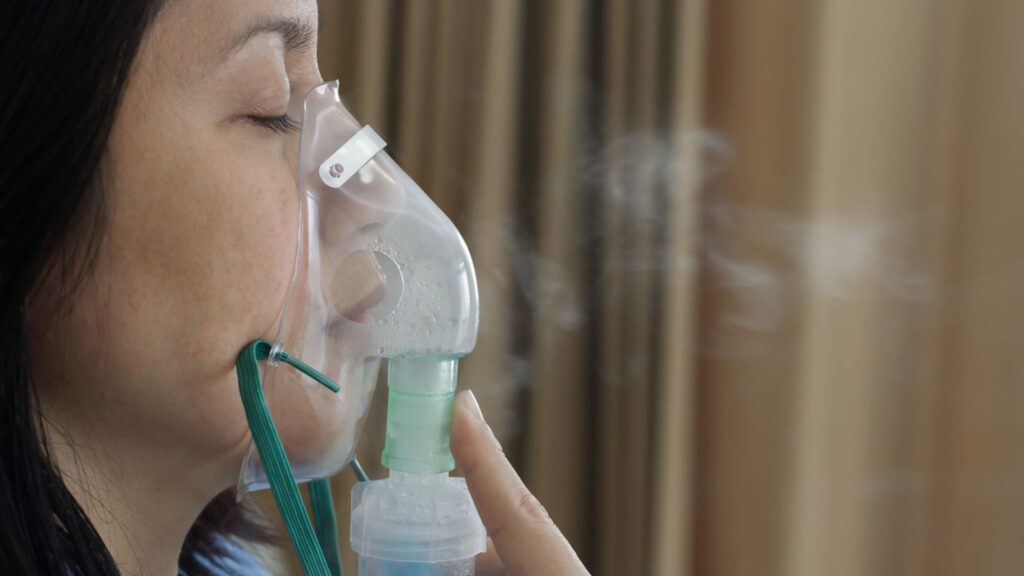Air is essential for life, but breathing in too much oxygen can be harmful and even toxic to the body. Oxygen poisoning, also known as oxygen intoxication or toxicity, occurs when the concentration or partial pressure of the gas becomes too high, leading to damage in various organs.
This article explains this complex condition, its causes, symptoms, risks, and how it can be prevented.

Understanding Oxygen Intoxication
Oxygen intoxication is a medical condition caused by breathing it at levels higher than normal atmospheric concentration, such as in hyperbaric oxygen therapy (HBOT) or scuba diving. This intoxication, often referred to as toxic oxygen exposure, can affect the central nervous system, lungs, and eyes, resulting in serious health consequences. The toxic effects are typically classified into central nervous system toxicity, pulmonary toxicity, and ocular toxicity, each affecting different organs in distinct ways.
Causes and Risk Factors
Oxygen poisoning mainly occurs when a person is exposed to a high concentration for prolonged periods.
While HBOT offers significant therapeutic benefits by increasing oxygen levels to promote healing and combat infections, it can also pose certain risks if not carefully managed. During HBOT procedures, exposure to high oxygen concentrations under increased pressure may lead to oxygen toxicity, with side effects such as ear discomfort, sinus pressure, vision changes, and, in rare cases, seizures caused by central nervous system oxygen intoxication. The likelihood of these adverse effects rises with higher chamber pressures and longer treatment durations, which is why strict medical supervision and carefully controlled protocols are essential to maximize HBOT’s benefits while minimizing the risk of poisoning.
This condition is also a significant risk for scuba divers breathing oxygen-enriched air at increased pressures underwater. This condition, known as central nervous system oxygen toxicity, can cause symptoms such as visual disturbances, ringing in the ears, nausea, dizziness, twitching, and in severe cases, convulsions or seizures. Because seizures underwater can lead to drowning or embolism, managing oxygen partial pressures and exposure times during dives is critical for diver safety. Divers are advised to follow strict protocols on maximum oxygen exposure to prevent this dangerous form of poisoning.
How its Mechanism of Toxicity Works
The harmful effects of oxygen poisoning arise from the production of reactive oxygen species (ROS), also called free radicals, that form in excessive amounts during exposure to high levels. These reactive species cause oxidative stress that damages cell membranes, proteins, DNA, and mitochondria.
In the lungs, this damage leads to inflammation, collapse of alveoli, and impaired transfer into the blood. In the central nervous system, oxidative damage affects neurons and blood vessels, potentially causing seizures and neurological symptoms. The accumulation of toxic oxygen species disrupts normal cellular functions, leading to organ dysfunction and potentially lethal outcomes.
Signs and Symptoms
Symptoms of poisoning or toxicity vary depending on the organ system involved and the severity of exposure. Central nervous system symptoms commonly include visual disturbances such as tunnel vision, ringing in the ears (tinnitus), facial twitching, nausea, dizziness, confusion, and in severe cases, convulsions or seizures.
Pulmonary symptoms of oxygen poisoning include coughing, chest pain, difficulty breathing, and inflammation of lung tissues.
Ocular toxicity can cause temporary vision changes like myopia or retinal damage. Early signs such as mild throat irritation or muscle twitching should prompt medical evaluation to prevent progression to severe poisoning.
Diagnosis and Medical Evaluation
Diagnosing oxygen poisoning involves a comprehensive medical history focusing on recent oxygen therapy, hyperbaric oxygen exposure, or scuba diving activities. Physical examination assesses respiratory and neurological function. Measurement of saturation in the blood and arterial blood gases helps evaluate levels and gas exchange in the lungs.
Imaging studies may be required to detect lung damage, such as pulmonary edema or atelectasis. Healthcare providers use these assessments to identify toxicity early and differentiate it from other conditions like carbon monoxide poisoning or hypoxemia caused by low levels.

Treatment and Management
The primary treatment for oxygen poisoning is immediate reduction or cessation of exposure to prevent further damage. In cases involving lung injury, supportive care such as delivery at normal or reduced concentrations, mechanical ventilation, or chest tube insertion for lung collapse may be necessary.
For central nervous system symptoms like seizures, appropriate anticonvulsant medications and intensive care monitoring are required. Recovery can take days to weeks as lung tissues heal, and affected organs regain function. Ongoing medical supervision is critical to monitor complications and prevent long-term damage.
Prevention and Safety Measures
Preventing poisoning or toxicity involves controlling the amount delivered in medical or recreational settings. Healthcare providers carefully adjust supplemental flow rates and monitor blood oxygen levels to maintain safe tension. During HBOT and scuba diving, strict protocols limit the duration and partial pressure of exposure to the gas to avoid toxic effects.
Education for patients and divers emphasizes the importance of following prescribed use and diving safety guidelines. Regular monitoring and adjustment of delivery systems help minimize the risk of toxic exposure.
When to Seek Medical Help
Seek immediate medical attention if you experience symptoms such as persistent coughing, chest pain, difficulty breathing, dizziness, confusion, seizures, or visual disturbances after using supplemental oxygen, undergoing HBOT, or diving.
Early intervention can prevent severe complications and improve recovery. Contact your healthcare provider for evaluation if symptoms worsen or new signs of toxicity develop.
Final Thoughts from Quantum Wellness Center
Oxygen poisoning is a serious but preventable condition caused by breathing excessive oxygen at high concentrations or pressures. Exposure to toxic levels can damage the lungs, central nervous system, and eyes, and may lead to seizures, respiratory distress, or even death. Proper medical supervision, adherence to therapy protocols, and safety measures during diving or hyperbaric treatment are essential to prevent poisoning.
At Quantum Wellness Center, our patients receive customized hyperbaric oxygen therapy in Sarasota, FL, designed to safely unlock the body’s natural healing potential. While HBOT offers significant therapeutic benefits, it is important to understand that improper use or exposure to excessive oxygen levels without supervision can lead to poisoning. That’s why expert care and strict protocols ensure your treatment is both effective and safe, supporting your journey to optimal wellness.



